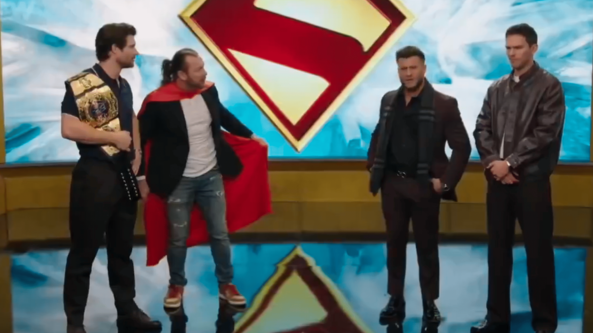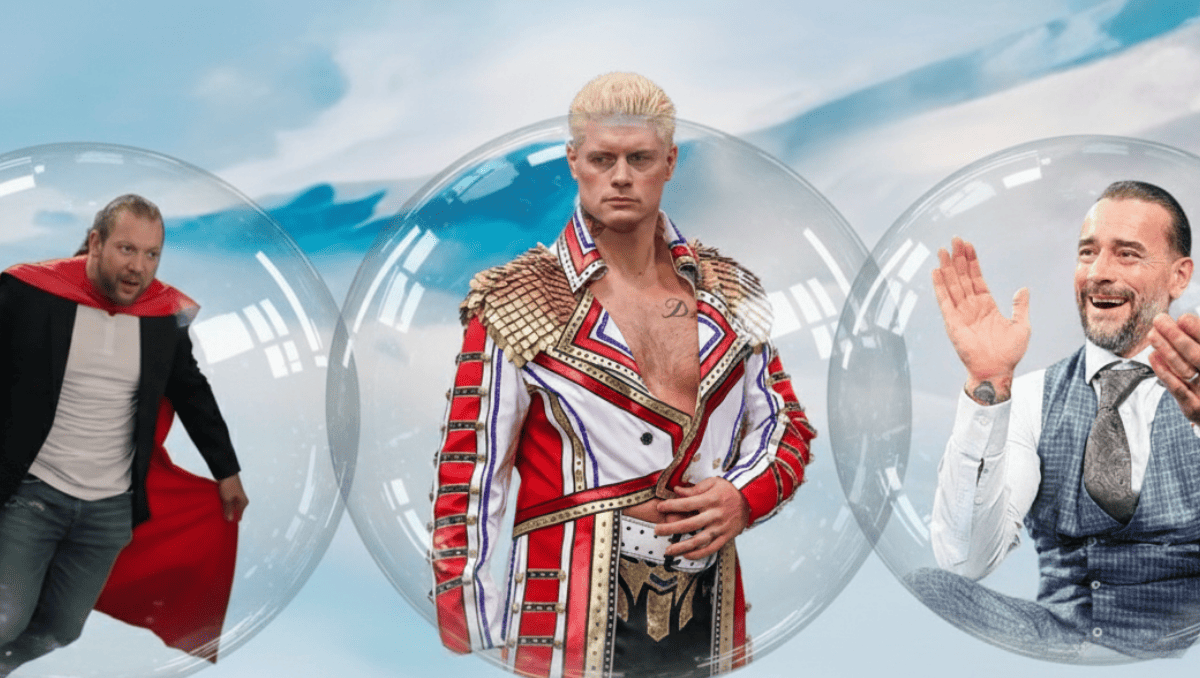Wrestling died. We just haven’t buried the body yet.
Ten million Americans tuned into wrestling weekly during the late ’90s. Today, Raw barely scrapes two million viewers globally. But scroll through Wrestling Twitter for five minutes and you’d think we’re living through the greatest boom period since Hulkamania.
Spoiler alert: We’re not.
Welcome to the Bubble
We’re trapped in what we’re calling the Wrestling Whirlpool™, a self-sustaining vortex of analysis, star ratings, and keyboard warriors convincing themselves they’re part of something culturally relevant. Everyone’s tweeting. Everyone’s rating. Everyone’s having very serious conversations about “work rate.”
Nobody’s actually watching.
The bubble spins faster each year, creating the illusion of momentum while going absolutely nowhere. Same moves. Same beats. Same “instant classics” that you’ll forget by next Tuesday.
The Fake Problem (That Isn’t Actually a Problem)
Here’s where it all went wrong: Wrestling got its feelings hurt.
Some MMA bro called wrestling fake, and instead of shrugging and cashing checks, the entire industry developed a complex. Wrestlers started performing like they’re defending a doctoral thesis. Fans started grading matches like they’re adjunct professors with anger issues.
The punchline? It’s still scripted. It’s athletic theater, and that’s not an insult; it’s the entire point.
Athletic ability was never supposed to eclipse storytelling. But here we are, watching 30-minute technical exhibitions designed to prove wrestling is “legitimate,” while forgetting that legitimacy was never what made it great.
The Template Killed Wrestling
Remember when wrestling was unpredictable? Beer trucks and ambulance crashes and segments that felt dangerously close to falling apart?
Now we have The Formula™:
- Respectful staredown (we’re athletes now)
- Chain wrestling exhibition (look how technical we are!)
- Choreographed dive sequence
- Finishing stretch begins
- First finisher, kickout at 2.999
- Superkick, kickout
- Canadian Destroyer, kickout
- Finisher from the heavens, still a kickout
- Standing ovation
- “This is awesome!” chants
Rinse. Repeat. Call it a banger.
It’s like watching cooking shows where every chef makes the exact same risotto, uses the same technique, plates it identically, and somehow the judges still act surprised when it tastes like… risotto.
Everyone knows the formula. The “shocking” kickout that shocks nobody. The false finish that was telegraphed three moves ago. But we’ve collectively agreed to pretend it’s spontaneous.
It stopped being wrestling. It became a choreographed ceremony we’ve trained ourselves to appreciate.
The Ratings Economy Broke Everything
Modern wrestling doesn’t run on ticket sales or TV deals anymore. It runs on imaginary internet points.
Cagematch ratings. Meltzer stars. Reddit upvotes. These are the metrics that dictate what wrestling looks like in 2025.
And what do these ratings actually measure? Not emotion. Not memorable moments. Not whether you’ll tell your friends about it.
Just move count. Finisher kickouts. Dive sequences.
Someone cracked the code: Do X, Y, and Z = automatic five stars.
So now everyone does X, Y, and Z. Forever.
The ratings system doesn’t reward promos. It ignores character work. It has no algorithm for storytelling, heat, or anything that happens outside the ropes. Just in-ring content. Just the template.
A match hits 4.75 stars and gets labeled a masterpiece, even if you can’t recall a single moment the next morning. Even if nobody outside the bubble knows it happened.
Because here’s the reality check: Casual fans have no clue what a “five-star match” means. They care about characters they can invest in, stories that build somewhere, moments that make them feel something.
But inside the bubble, we’ve engineered a perfect feedback loop:
- Fans rate what they’ve been conditioned to like
- Wrestlers perform specifically to get those ratings
- The loop perpetuates itself
Wrestling didn’t evolve. It got exploited.
Even the Bookers Fell for the Scam
Tony Khan openly admits he books for Cagematch ratings. Out loud. On record. Meanwhile, AEW’s viewership has been sliced in half since launch.
Triple H claims he doesn’t care about online discourse, yet WWE programming has become weaponized Twitter bait. Random returns. “Surprise” debuts. Shows with zero narrative progression, just moments™ designed for social media clips.
The matches are good. Too good, actually. So polished that everything surrounding them feels disposable.
And the audience? Still shrinking.
It’s the same million people watching more intensely than ever, rating every match, convinced their echo chamber represents mainstream culture.
The bubble isn’t expanding. It’s compressing.
The Celebrity Tourist Trap
Then celebrities show up and everyone loses their minds. “Wrestling’s mainstream again!”
Press X to doubt.
Bad Bunny. Logan Paul. Travis Scott. Look closer, they’re all Attitude Era kids who got famous doing something else and came back for a nostalgia hit. They’re not here because wrestling is culturally relevant in 2025. They’re here because they miss what it used to be.
They punch someone, generate a headline, then vanish.
Bad Bunny feuds with Damien Priest, disappears. Logan Paul challenges Roman, gone. Travis Scott punches Cody, literally never seen again.
They’re not joining the wrestling world. They’re visiting a museum.
And they don’t even respect it anymore. Because they can tell this isn’t what they grew up loving.
But somehow the bubble calls this a “boom period.”
It’s not a boom. It’s nostalgia cosplay with better production values.
Workrate Replaced Charisma (And Nobody Noticed)
In a scripted sport, athletic ability should never matter more than storytelling.
But it does.
Wrestlers who can’t cut promos, can’t develop characters, can’t make you feel anything, they get mega-pushes because they can wrestle for 40 minutes without botching.
Workrate became the new charisma. Athleticism replaced personality. And fans gaslit themselves into thinking this represents progress.
Take someone like Iyo Sky. Athletic? Undeniably. Can she deliver a compelling promo? Can she anchor a storyline? Does she have the entertainment factor to justify top-tier positioning?
But she gets five-star matches, so those questions get dismissed as outdated thinking.
Look across the roster. How many “top stars” are genuinely entertaining? Cody Rhodes? Seth Rollins? They’re talented professionals doing competent work.
But are they making you feel something? Or are they just… there?
You don’t need to create genuine emotional investment anymore. You just need to hit your marks and make people clap on command.
Because if it gets five stars, it must’ve been good, right?
The Superman Reality Check
Every bubble eventually collides with reality.
Remember that AEW x Superman crossover promo? Kenny Omega and MJF are standing beside the cast of Hollywood’s latest superhero movie.
They looked… small. Not just height-wise. Dimensionally smaller.

For decades, wrestling sold itself on spectacle. Giants. Monsters. Humans who looked like they were chiseled from mythology. That visual spectacle is what attracted casual viewers, curiosity, intimidation, and fascination.
Now we’ve convinced ourselves that it doesn’t matter. That charisma can be substituted with cardio. That “larger-than-life” can be replaced with “technically proficient.”
Sure, Kenny can hit a V-Trigger that breaks physics. MJF can deliver promos sharp enough to draw blood. They’re exactly what modern fans claim wrestling should be.
But stand them next to actual celebrities, and the bubble deflates instantly.
To the outside world, they don’t register as legends. They look like stunt coordinators who spent too long in the gym.
Highly choreographed. Perfectly timed. Like competitive ballroom dancing with pile drivers.
Because no matter how many flips or stars you accumulate, the real draw was never the precision. It was the presence.
And somewhere along the way, wrestling got embarrassed about its larger-than-life nature. As if being spectacular was something to apologize for.
The Attitude Era Knew What It Was
During the Attitude Era, wrestling was absurd, and that’s precisely why it worked. It understood its identity and leaned into the chaos.
Stone Cold flooding the ring with beer. Vince McMahon’s hospital bed shenanigans.
Over-the-top. Ridiculous. Entertaining.
Modern wrestling is serious, and that’s why it fails.
We traded chaos for choreography. Stories for sequences. Entertainment for technique. Characters for athletes.
And we convinced ourselves this is what people wanted.
Still Spinning
The fans keep clapping. Keep rating. Keep spinning in the same circle.
Chanting the same chants. Watching the same match with different wrestlers. Convincing themselves they’re part of something growing.
The viewership continues declining. But inside the bubble, everything’s fine.
Maybe wrestling isn’t fake anymore.
Maybe it’s just stuck.
Because the most dangerous thing about bubbles isn’t when they burst.
It’s when they convince you you’re still ascending, even as you’re clearly sinking.

